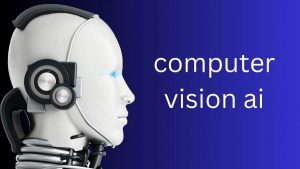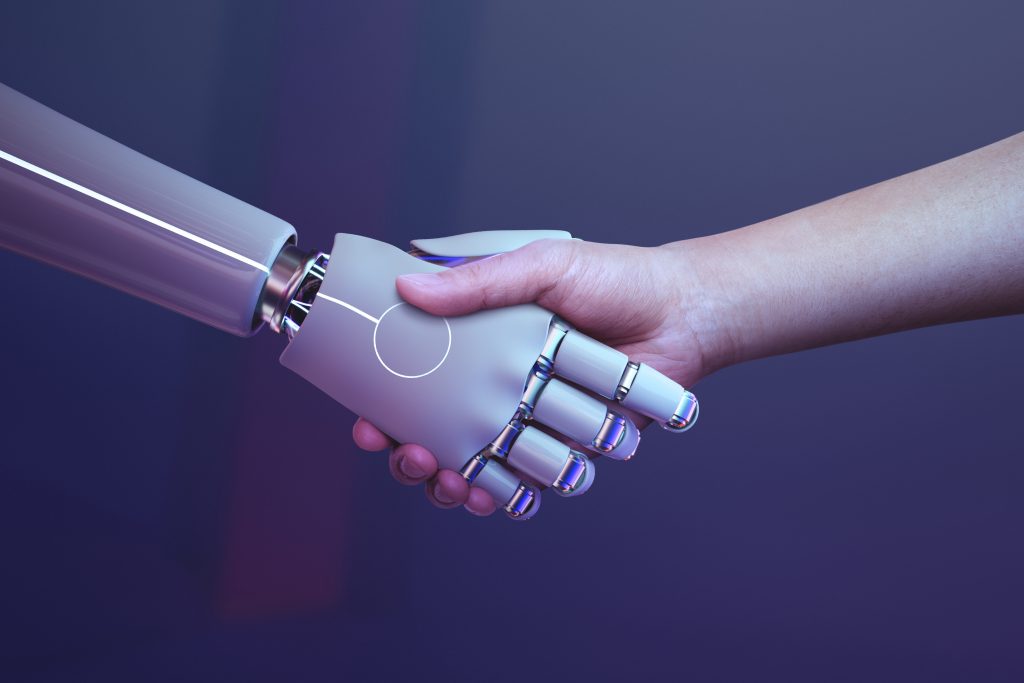computer vision ai

first Python programming-introduction Python programming
what is AI // क्या है ai //type of ai
what is machine learning (ml)?what is a risk to data when training a machine learning (ml) application?
Reinforcement learning- (RL)-What is RL in reinforcement?-introduction
Computer vision is a multidisciplinary field of study
that focuses on enabling computers to interpret,
understand, and process visual information from the world, like
human vision. It involves developing algorithms and
techniques to extract meaningful insights and knowledge from
images, videos, and other visual data. The ultimate goal of
computer vision is to enable machines to see and understand
the visual world as humans do. Computer vision covers a wide
range of functions and applications Image
USE
computer vision ai
Classification:
Assigning a
label or category to an image. For example, identifying whether there
is a cat or a dog in an image. Object Detection: Identifying and
localizing specific objects within an image. This involves creating a
bounding box around objects of
interest. Semantic segmentation:
Assigning a semantic label to each pixel in an image, effectively
dividing the image into meaningful areas.
Example Segmentation: Similar to semantic segmentation, but
separating different instances ofo bjects within the same class.
USE
computer vision ai
Image creation:
ai
creating new images that resemble a given dataset. This includes functions such
as style transfer, image synthesis, and super-resolution.
Facial recognition: Identifying and verifying individuals based on
facial features. Gesture and posture
recognition: Detecting and understanding human gestures and
postures in images or videos. Object tracking: Following the
motion of objects over time in the video.
USE
computer vision ai
Understanding the scene:
Estimating high-level information
about a scene, such as its layout, relationships between
objects, and overall context. Medical Imaging: Analyzing
medical images such as X-rays, MRIs, and CT scans to aid in
diagnosis and treatment
planning. Autonomous vehicles: enabling
self-driving cars to understand their surroundings and make decisions
based on visual data. Augmented reality (AR) and virtual
reality (VR): enhancing real-world experiences with digital information
or creating intense virtual environments.
USE
computer vision ai
Image classification:
Assigning a label or category to an input image.
For example, identifying whether there is a cat or a dog in an image.
Object Detection: Identifying and localizing specific objects within an
image. It is commonly used in applications such as autonomous
driving, where the system needs to detect
pedestrians, vehicles, and traffic signals.
USE
computer vision ai
Image segmentation:
Dividing an image into segments or regions
based on similar properties. It can be used to identify the boundaries of
objects within an image. Face recognition: Identifying and
verifying individuals based on facial features. This technology is used in
security systems, biometric authentication and more.
Gesture Recognition: Interpreting human gestures and activities, often
used in applications such as gaming and human-computer interaction.
USE
computer vision ai
Object Tracking:
Continuously tracking the movement of specific
objects across frames in a video. Understanding the scene:
Inferring high-level information about a scene, such as the
relationship between objects, the layout of the location,
and the overall context. Medical image analysis:
Analyzing medical images such as X-rays, MRIs and CT scans to
aid in the diagnosis of diseases and conditions.
Augmented reality (AR) and virtual reality (VR):
USE
computer vision ai
overlapping digital information on the real world or creating intense virtual
environments by understanding and interacting with real-world scenes.
Computer vision combines techniques from various
fields including image processing, machine learning, deep learning,
geometry, and statistics. Over the past few years, advances in
hardware, especially graphics processing units
(GPUs), and the availability of large datasets have fueled rapid
advances in computer vision. Deep learning, in particular, has
played an important role in achieving cutting-edge results in
many computer vision tasks, enabling computers to learn
complex features and patterns directly from visual data.
Computer vision has a wide range of practical applications in
healthcare, automotive, entertainment,
manufacturing, agriculture, security and other industries. It is
constantly evolving and contributing to innovations that
improve our interaction with the visual world and enhance
automation and decision-making
processes.
first Python programming-introduction Python programming
Reinforcement learning- (RL)-What is RL in reinforcement?-introduction
what is AI // क्या है ai //type of ai
FAQ
What is computer vision AI?
SUGGESTION
computer vision ai
Computer vision AI is like giving computers the power to understand and make sense of what they see. It helps machines recognize objects, people’s faces, or even understand scenes from images and videos, much like how humans do. This technology is used in things like self-driving cars, security systems, and medical diagnostics to help them “see” and make smart decisions based on what they see.
Is computer vision ml or AI?
SUGGESTION
computer vision ai
Computer vision is a subset of artificial intelligence (AI). It uses machine learning (ML) techniques to enable machines to understand and interpret visual data, such as images and videos. So, in simple terms, computer vision is a part of AI that relies on ML to process and analyze visual information.
Which is an example of machine vision AI?
SUGGESTION
computer vision ai
An example of machine vision AI is automated quality control in manufacturing. In this application, computer vision systems are used to inspect and identify defects in products as they move along a production line. The system can analyze visual data from cameras and make real-time decisions about the quality of each item. If a defect is detected, the system can trigger actions such as flagging the product for manual inspection or diverting it away from the production line. This use of machine vision AI helps ensure the consistent quality of manufactured goods and reduces the need for human inspection, leading to increased efficiency and cost savings in manufacturing processes.
What are the benefits of computer vision in AI?
SUGGESTION
computer vision ai
Computer vision in AI has several benefits:
1. Automation: It helps machines understand and interpret visual data, enabling automation in various tasks like image recognition and object tracking.
2. Enhanced Efficiency:AI with computer vision can process large amounts of visual information quickly and accurately, improving efficiency in tasks like quality control or content sorting.
3. Safety: It’s used in autonomous vehicles and surveillance systems to enhance safety by identifying objects and potential risks.
4. Accessibility: It can make technology more accessible, such as assisting visually impaired individuals by providing real-time descriptions of their surroundings.
5. Healthcare: In healthcare, it aids in medical imaging for disease diagnosis and treatment planning.
6. Entertainment: It enhances gaming and entertainment experiences through facial recognition, augmented reality, and virtual reality.
7. Security: It improves security by detecting anomalies or unauthorized access in surveillance systems.
8. Innovation: It drives innovation by enabling new applications like smart cities, robotics, and more.
Overall, computer vision in AI improves efficiency, safety, accessibility, and innovation across various industries.
Is computer vision easy to learn?
SUGGESTION
computer vision ai
Computer vision is not considered easy to learn. It involves
complex concepts in mathematics, programming, and machine learning.
It requires dedication, time, and effort to become proficient in this field.
Is computer vision a good career?
SUGGESTION
computer vision ai
Yes, computer vision can be a rewarding and promising career if you have the right skills and interest in the field.


